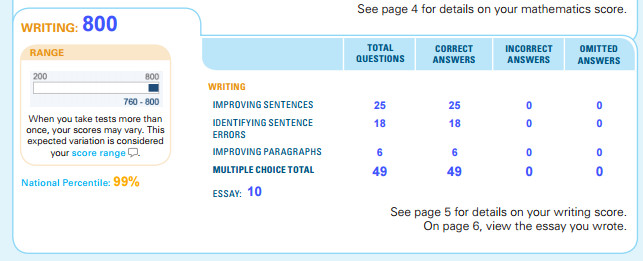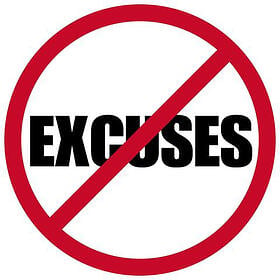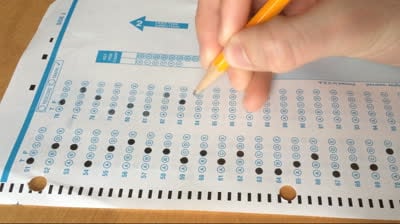
Are you scoring in the 600–750 range on SAT Writing? Do you want to raise that score as high as possible—to a perfect 800?
UPDATE: This article discusses a previous version of the SAT. If you are looking to get a perfect score on the digital SAT, check out my guide to getting an 800 on SAT Reading and Writing.
Getting to an 800 SAT Writing score isn't easy. It'll require near perfection and a mastery of both grammar rules and essay writing. But with hard work and my SAT writing strategies below, you'll be able to do it. I've consistently scored 800 on Writing on my real SATs, and I know what it takes. Follow my advice, and you'll get a perfect score—or get very close.
Brief note: This article is suited for students already scoring a 600 on SAT Writing or above (this equates to a Writing Test Score of 30+ out of 40 on the New SAT). If you're below this range, my "How to Improve your SAT Writing Score to a 600" article is more appropriate for you. Follow the advice in that article, then come back to this one once you've reached a 600.
Also, the New 2016 SAT now has a single 800 Reading + Writing score, combining the individual Reading and Writing test scores. Technically, when I mention a perfect Writing test score, I'm referring to a perfect 40/40 test score, which is essential to getting an 800 Reading and Writing score. In this guide, I'll use 800 and 40 interchangeably to mean a perfect Writing score. We won't talk about Reading here, but if you want to improve your Reading score too, check out my Perfect SAT Reading score guide.
Overview
Most guides on the internet on how to get an 800 on SAT Writing are pretty low quality. They're often written by people who never scored an 800 themselves. You can tell because their advice is usually vague and not very pragmatic.
In contrast, I've written what I believe to be the best guide on getting an 800 available anywhere. I have confidence that these strategies work because I used them myself to score 800 on SAT Writing consistently. They've also worked for thousands of my students at PrepScholar.
In this article, I'm going to discuss why scoring an 800 is a good idea, what it takes to score an 800, and then go into the nine key SAT Writing strategies so you know how to get an 800.
Stick with me—as an advanced student, you probably already know that scoring high is good. But it's important to know why an 800 Writing score is useful, since this will fuel your motivation to get a high score.
This guide has been updated for the New 2016 SAT Writing and Language section, so you can be sure my advice works for the test you're about to take.
Final note: In this guide, I talk mainly about getting to an 800. But if your goal is a 700, these strategies still equally apply.
Understand the Stakes: Why an 800 SAT Writing?
Let's make something clear: for all intents and purposes, a 1540+ on an SAT is equivalent to a perfect 1600. No top college is going to give you more credit for a 1600 than a 1540. You've already crossed their score threshold, and whether you get in now depends on the rest of your application.
So if you're already scoring a 1560, don't waste your time studying trying to get a 1600. You're already set for the top colleges, and your time is better spent working on the rest of your application.
But if you're scoring a 1520 or below AND you want to go to a top 10 college, it's worth your time to push your score up to a 1530 or above. There's a big difference between a 1460 and a 1560, largely because it's easy to get a 1460 (and a lot more applicants do) and a lot harder to get a 1560.
A 1540 places you right around average at Harvard and Princeton, and being average is bad in terms of admissions, since the admissions rate is typically below 10%.
So why get an 800 in SAT Reading+Writing? Because it helps you compensate for weaknesses in other sections. By and large, schools consider your composite score moreso than your individual section scores. If you can get a perfect 40 in SAT Writing and a perfect 40 in SAT Reading, that means you only need a 750 in SAT Math. This gives you a lot more flexibility.

There's another scenario where an 800 in SAT Writing is really important: if you're planning to apply as a humanities or social science major (like English, political science, communications) to a top school.
Here's the reason: college admissions is all about comparisons between applicants. The school wants to admit the best, and you're competing with other people in the same "bucket" as you.
By applying as a humanities/social science major, you're competing against other humanities/social science folks: people for whom SAT Writing is easy. Really easy.
Here are a few examples from schools. For Harvard, Princeton, Yale, and Dartmouth, the 75th percentile SAT Reading+Writing score is an 800. That means at least 25% of all students at these schools have an 800 in SAT Writing.
But if you can work your way to an 800, you show that you're at an equal level (at least on this metric). Even if it takes you a ton of work, all that matters is the score you achieve at the end.

Know That You Can Do It!
This isn't just some fuzzy feel-good message you see on the back of a milk carton.
I mean, literally, you and every other reasonably intelligent student can score an 800 on SAT Writing.
The reason most people don't is they don't try hard enough or they don't study the right way.
Even if language isn't your strongest suit, or you got a B+ in AP English, you're capable of this.
Because I know that more than anything else, your SAT score is a reflection of how hard you work and how smartly you study.
SAT Writing is Designed to Trick You — You Need to Learn How
Here's why: the SAT is a weird test. When you take it, don't you get the sense that the questions are nothing like what you've seen in school?
You've learned grammar before in school. You know some basic grammar rules. But the SAT questions just seem so much weirder.
It's purposely designed this way. The SAT can't test difficult concepts because this would be unfair for students who never took AP English. It can't ask you to decompose Dostoevsky's The Brothers Karamazov. The SAT is a national test, which means it needs a level playing field for all students around the country.
So it HAS to test concepts that all high school students will cover. Subject verb agreement, run-on sentences, pronoun choice, etc. You've learned all of this throughout school.
But the SAT still has to make the test difficult, so it needs to test these concepts in strange ways. This trips up students who don't prepare, but it rewards students who understand the test well.
Example Question
Here's an example: find the grammar error in this sentence:
This is a classic SAT Writing question.
The error is in subject/verb agreement. The subject of the sentence is commissioner, which is singular. The verb is "run," but because the subject is singular, it should really be "runs."
At your level, you probably saw the error. But if you didn't, you fell for a classic SAT Writing trap. It purposely confused you with the interrupting phrase, "along with his 20 staff members." You're now picturing 20 people in a campaign—which suggests a plural verb!
The SAT Writing section is full of examples like this, and they get trickier. Nearly every grammar rule is tested in specific ways, and if you don't prepare for these, you're going to do a lot worse than you should.
Here's the good news: this might have been confusing the first time, but the next time you see a question like this, you'll know exactly what to do: find the subject and the verb, and get rid of the interrupting phrase.
So to improve your SAT Writing score, you just need to:
- Learn the grammar rules that the SAT tests.
- Study how the SAT tests these grammar rules and learn how to detect which grammar rule you need in a question.
- Practice on a lot of questions so you learn from your mistakes.
I'll go into more detail about exactly how to do this. First, let's see how many questions you need to get right to get a perfect score.
What It Takes to Get An 800 in Writing
If we have a target score in mind, it helps to understand what you need to get that score on the actual test.
On the Writing section, there are 44 multiple-choice questions. How many questions you get right determines your scaled score out of 40.
From the Official SAT Practice Tests, I've taken the raw score to scaled score conversion tables from the first four tests. (If you could use a refresher on how the SAT is scored and how raw scores are calculated, read this.)
| Raw Score | Test 1 | Test 2 | Test 3 | Test 4 |
| 44 | 40 | 40 | 40 | 40 |
| 43 | 39 | 39 | 39 | 39 |
| 42 | 38 | 38 | 38 | 38 |
| 41 | 37 | 37 | 37 | 37 |
| 40 | 36 | 36 | 36 | 37 |
| 39 | 35 | 35 | 35 | 36 |
| 38 | 34 | 34 | 35 | 35 |
| 37 | 34 | 33 | 34 | 34 |
These grading scales are harsh. For every test, if you miss just ONE question, you get dropped down to a 39. This means your maximum Reading + Writing score becomes a 790, in the best case.
The exact score conversion chart depends on the difficulty of this test. This particular score chart is as strict as it gets—sometimes, you can miss one question and still get a 40. But I've never seen a test allow missing two questions and getting a 40. Sometimes, if you miss two questions, you drop down to a 37.
So the safest thing to do is to aim for perfection. On every practice test, you need to aim for a perfect raw score for an 800, and an essay score of at least 10.
It's pretty clear then that you need to try to answer every question. You can't leave any questions blank and expect to get an 800 reliably, which means you need to get to a level of mastery where you're confident answering each question.
Whatever you're scoring now, take note of the difference you need to get to a 800. For example, if you're scoring a 38 raw score now, you need to answer six more questions right to get to a perfect 40.
As a final example, here's a screenshot from my exact score report from March 2014, showing that I missed 0 questions and earned an 800.

(This was from the older 2400 version of the SAT, but the grading scale was similarly tough back then.)
OK—so we've covered why scoring a higher Writing score is important, why you specifically are capable of improving your score, and the raw score you need to get to your target.
Now we'll get into the meat of the article: actionable strategies that you should use in your own studying to maximize your score improvement.
9 Strategies to Get an 800 on SAT Writing

Strategy 1: Understand Your High-Level Weakness: Time Management, Content, or Essay Score
We're deliberately starting high level, before diving into grammar rules, because you need to know what type of game you're playing before you practice.
Every student has different flaws in SAT Writing. Some people don't have full mastery of the grammar rules. Others run out of time on the test. Yet others aren't fluent in their essay writing.
Here's how you can figure out which one applies more to you:
- Find an official SAT practice test, and take only the Writing section. We have the complete list of free practice SATs here.
- For each section, use a timer and have it count down the 35 minutes for the Writing section. Treat it like a real test.
- If time runs out and you're 100% ready to score your exam, then do so. If you're not ready to move on, keep on working for as long as you need. For every new answer or answer that you change, mark it with a special note as "Extra Time."
- Grade your test using the answer key and score chart, but we want two scores: 1) The Realistic score you got under normal timing conditions, 2) The Extra Time score. This is why you marked the questions you answered or changed during Extra Time.
See what we're doing here? By marking which questions you did under Extra Time, we can figure out what score you would get if you were given all the time you needed. This will help us figure out where your weaknesses lie.
If you didn't take any extra time, then your Extra Time score is the same as your Realistic score.
Here's a flowchart to help you figure this out:
Was your Extra Time scaled score a 35 or above?
If NO (Extra Time score < 35), then you have strategy and content weaknesses. All the extra time in the world couldn't get you above a 35, so your first angle of attack will be to find your weaknesses and attack them (We'll cover this later).
If YES (Extra Time score > 35), then:
Was your Realistic raw score a 43 or above?
If NO (Extra Time score > 35, Realistic < 35), then that means you have a difference between your Extra Time score and your Realistic score. If this difference is more than three points, then you have some big problems with time management. We need to figure out why this is. Are you taking too much time for each question? Or are particular types of questions slowing you down? More on this later.
If YES (both Extra Time and Realistic scores > 35), then you have a really good shot at getting an 800. Compare your Extra Time and Realistic score—if they differed by more than two points, then you would benefit from learning how to solve questions more quickly. If not, then you likely can benefit from shoring up on your last content weaknesses and avoiding careless mistakes (more on this strategy later).
Hopefully that makes sense. Typically I see that students have both timing and content issues, but you might find that one is much more dominant for you than the other. For example, if you can get a 40 with extra time, but score a 35 in regular time, you know with certainty that you need to work on time management to get a 40.

Strategy 2: Comprehensively Learn the Grammar Rules
There's just no way around it. You need to know all the grammar rules tested on the test and how they work.
Certain grammar rules, like punctuation usage, appear far more often than other rules. But because we're going for perfection, you'll need to know even the less-common rules.
In our PrepScholar program, we've identified the following as the most to least important grammar rules:
- Punctuation
- Sentence Structure
- Conventional Expression (aka idioms)
- Possessives
- Agreement
- Parallel Structure
- Modifiers
- Verb Tense
- Pronouns
Within these general categories, there are a lot of rules, but they differ from each other in how often they appear on the test and how hard they are to study.
For example, Punctuation is by far the most common grammar rule on SAT Writing, but it only uses a few separate concepts. The Idioms skill is slightly less common, but it uses a wide range of idioms (like "as a means of" or the use of "whereby" vs "from which"), such that each unique idiom appears no more than once on each test.
As another example, Punctuation appears 4.12 times as often on SAT Writing as the least common concept, Pronouns. So, assuming you're equally weak across all skills, you get more bang for your buck by studying Punctuation and nailing it.
It's therefore important for you to focus your time on studying the highest impact grammar rules. Our PrepScholar program, for example, quizzes you in relation to how common each grammar rule is, so that you focus your efforts on the rules that make the biggest difference to your score.
Strategy 3: Get Intimately Familiar With the Rhetoric Question Types
Aside from grammar rules, the other major category of questions in SAT Writing is what we call Rhetoric. These questions concern how to make persuasive arguments and construct logical sentences, paragraphs, and essays. The College Board also calls this "Command of Evidence" and "Expression of Ideas."
Unlike sentences with incorrect grammar, sentences in rhetoric questions don't usually have anything technically wrong with them. Instead, the SAT is testing you to find more effective ways to construct the sentence or passage.
Here's a rundown of the types, from most common to least:
- Sentence Function
- "At this point, the writer is considering adding the following sentence...Should the writer make this addition here?"
- Concision
- "Which choice most effectively combines the two sentences at the underlined portion?"
- Transition
- These questions underline a key transition word in between sentences or phrases. You need to pick the transition that makes the most sense.
- Example: "This assertion is not supported by scientific research. For instance, one review published in..."
- Logical sequence
- "To make this paragraph most logical, sentence 2 should be placed..."
- These questions require you to order the sentences to get the most logical flow.
- Precision
- These questions underline a word or phrase and ask you to pick the best replacement for them. This is as close to a vocab test as the SAT gets.
- Example: "The reason for Siqueiros's secrecy became clear when the mural was confided." Answer choices: A) NO CHANGE, B) promulgated, C) imparted, D) unveiled.
- Quantitative
- These questions are the only ones in SAT writing that deal with graphs and data. You're usually asked to make sense of figures in the context of the text.
- Note - if you don't consider yourself a math person, don't be scared - the graphs are never super complex. But you do need to be able to read graphs and charts quickly.
- "Which choice offers an accurate interpretation of the data in the chart?"
- Style and tone
- These questions deal with maintaining the tone of the article - if it's a professional science article, it shouldn't use words like "icky" or "okay."
- Example: "The writer wants to convey an attitude of ___. Which choice best accomplishes the goal?"
Even though questions of a single type look the same, they do vary significantly in difficulty. The difficulty depends on how subtle the answer choices are and the passage context.
Once again, in our PrepScholar program, we break down every single Rhetoric skill and have thousands of practice questions to drill them to perfection.
Which brings us to:

Strategy 4: Do a Ton of Practice, and Understand Every Single Mistake
On the path to perfection, you need to make sure every single one of your weak points is covered. Even one mistake on all of SAT Writing can knock you down from an 800.
The first step is simply to do a ton of practice. If you're studying from free materials or from books, you have access to a lot of practice questions in bulk. As part of our PrepScholar program, we have over 4,500+ SAT questions customized to each skill.
The second step—and the more important part—is to be ruthless about understanding your mistakes.
Every mistake you make on a test happens for a reason. If you don't understand exactly why you missed that question, you will make that mistake over and over again.
I've seen students who did 20 practice tests. They've solved over 3,000 questions, but they're still nowhere near an 800 on SAT Writing.
Why? They never understood their mistakes. They just hit their heads against the wall over and over again.
Think of yourself as an exterminator, and your mistakes are cockroaches. You need to eliminate every single one—and find the source of each one—or else the restaurant you work for will be shut down.
Here's what you need to do:
- On every practice test or question set that you take, mark every question that you're even 20% unsure about.
- When you grade your test or quiz, review every single question that you marked, and every incorrect question. This way, even if you answered a question correctly by guessing, you'll make sure to review it.
- In a notebook, write down the gist of the question, why you missed it, and what you'll do to avoid that mistake in the future. Have separate sections by grammar skill (e.g. Number Agreement, Idioms, Sentence Fragments).
It's not enough to just think about it and move on. It's not enough to just read the answer explanation. You have to think hard about why you specifically failed on this question.
By taking this structured approach to your mistakes, you'll now have a running log of every question you missed, and your reflection on why.

No excuses when it comes to your mistakes.
Always Go Deeper—WHY Did You Miss a Writing Question?
Now, what are some common reasons that you missed a question? Don't just say, "I didn't get this question right." That's a cop out.
Always take it one step further—what specifically did you miss, and what do you have to improve in the future?
Take the Subject/Verb Agreement example I gave above (with the Interrupting Phrase trick). You likely already know how Subject/Verb Agreement works. But if you missed that question, you'd need to think about why you missed it (because the interrupting phrase made you confuse the subject and verb). Then you need to write down a strategy for noticing this in the future.
Here are some examples of common reasons you miss a Writing question and how you should take the analysis one step further:
Content: I didn't learn the grammar rule needed to answer this question.
One step further: What specific rule do I need to learn, and what resources will I use to learn this grammar rule?
Overlooked Rule: I knew the grammar rule, but the SAT question was written in a way that made me miss it.
One step further: How do I solve the question now? Is there a strategy I can use to notice this grammar rule in the future?
Careless Error: I knew the grammar rule and normally would get this right, but I slipped up for some reason.
One step further: Why did I make this careless mistake? Was I rushing? Did I misread the question? What should I do in the future to avoid this?
Get the idea? You're really digging into understanding why you're missing questions.
Yes, this is hard, and it's draining, and it takes work. That's why most students who study ineffectively don't improve.
But you're different. Just by reading this guide, you're already proving that you care more than other students. And if you apply these principles and analyze your mistakes, you'll improve more than other students too.
Strategy 5: Justify Every Answer. Point Out Specific Grammar Errors. Justify the Rhetoric Choice.
Many top students take a "soft approach" to SAT Writing. They learn the grammar rules when studying, but on the test they go "by ear": if a sentence sounds off, they'll assume it's wrong without thinking too hard about why.
When you've mastered grammar rules, this can serve you well. For example, if I said "The bee fly to the hive." You know this is wrong instantly—it just feels wrong. You know simple subject/verb agreement so well that you can tell something is wrong before you can articulate what exactly it is.
However, most students never get to this level of familiarity with all SAT grammar rules. This makes trusting your ear unreliable for many rules.
What's the strategy to counter this? Point out the specific error, and justify it to yourself.
This is especially true in rhetoric questions, where the answer choices can be vague and subtly different. You have to understand why one answer is definitely the right answer, and the other three answers are definitely the wrong answers. This is a standardized test.
Let's take one of the more difficult questions in an SAT practice test:

Try to solve it yourself if you like.
Here's what I'm thinking as I read the question (a "stream of consciousness"):
" 'Likewise, anyone considering a career as a video game designer must be skilled writers and speakers,' and 'skilled writers and speakers' is underlined. There's no clear glaring problem, but the end of the sentence is funky. 'Anyone' is singular, as is 'video game designer,' but it switches to plural 'skilled writers and speakers.' This is a number agreement error - it should be "a skilled writer and speaker." Let's look at the answer choices. B is exactly what I predicted. C and D both have the same issue of inappropriate plural forms, and, aside from this error, neither is that much better than A. So I'm pretty confident B is the best answer."
Now, I'm not literally thinking all these words in my head, but it matches my thinking process as I go through the question and evaluate each answer choice.
As you learn the different grammar skills and how they appear on the test, you'll start evaluating answer choices for common ways that the SAT tries to trick you.
Is a verb underlined? I'm going to check the subject to see if it follows subject/verb agreement. Then I'll check the verb tense.
Is a pronoun underlined? I'm going to check the antecedent to see if it matches.
Does an underline come right after a comma? I'm going to check if there's a faulty modifier error.
I can justify every one of my answers because I know the grammar rules. This makes my answering more robust, not just based on whether something 'feels' right or wrong.
Let's try another example for fun.

Try to solve it yourself if you like.
I'll start my stream of consciousness after I read the question:
"This is a classic illogical comparison error - you're comparing "organically grown crops" with "people." Crops aren't more nutritious than people! We need to compare organic crops with conventionally grown crops. So I need an answer choice that solves this:
- A: same as original, which is wrong
- B: "organic crops are safer than the purchase of their conventionally grown counterparts" - no - it's better than comparing crops to people, but it's still not comparing crops to crops
- C: "organic crops are safer than purchasing their conventionally grown counterparts" - no, same error. This would be fine if the sentence read "they believe purchasing organic crops is safer than purchasing conventionally grown counterparts." But it doesn't.
- D: "organically crops are safer than their conventionally grown counterparts" - yes! It's crops to crops, perfect.
You can see how I first identified the illogical comparison error in the original sentence. That made it very clear to me how I could find an answer choice that fixed this error.
Then I went through each answer choice, replacing the text and seeing if it fixed the error.
Note that in these questions, the SAT often fixes the original error in an answer choice—but then introduces another error. You need to make sure the answer you choose is 100% correct, in terms of both grammar and logic.
Don't be intimidated if you can't do this right now. With practice and reflection, you will get to this point.
Once again, it's like "the bee fly to the hive." You want to get to a point where all SAT grammar rules automatically sound as wrong as that sentence.

Find patterns to your mistakes, and make sense of the chaos.
Strategy 6: Find Patterns to Your Weaknesses and Drill Them
Remember Strategy 4 above, about keeping a lot of every mistake? You need to take this even one more step further.
If you're like most students, you're better at some areas in SAT Writing than others. You might know pronouns really well, but you'll be weak in sentence constructions and fragments. Or maybe you really like parallel construction, but you have no idea what faulty modifiers are.
If you're like most students, you also don't have an unlimited amount of time to study. You have a lot of schoolwork, you might be an athlete or have intense extracurriculars, and you have friends to hang out with.
This means for every hour you study for the SAT, it needs to be the most effective hour possible.
In concrete terms, you need to find your greatest areas of improvement and work on those.
Too many students study the 'dumb' way. They just buy a book and read it cover to cover. When they don't improve, they're SHOCKED.
I'm not.
Studying effectively for the SAT isn't like painting a house. You're not trying to cover your bases with a very thin layer of understanding.
What these students did wrong was they wasted time on subjects they already knew well, and they didn't spend enough time improving their weak spots.
Instead, studying effectively for the SAT is like plugging up the holes of a leaky boat. You need to find the biggest hole and fill it. Then you find the next biggest hole, and you fix that. Soon you'll find that your boat isn't sinking at all.
How does this relate to SAT Writing? You need to find the grammar rules that you're having most trouble in, and then do enough practice questions until they're no longer a weakness. Fixing up the biggest holes.
For every question that you miss, you need to identify the type of question it is and why you missed it. When you notice patterns to the questions you miss, you then need to find extra practice for this grammar rule.
Say you miss a lot of misplaced modifier questions. You need to find a way to get lesson material to teach yourself the main concepts that you're forgetting. Then you need to find more practice questions for this skill so you can drill your mistakes.
This is the best way for you to improve your Writing score.
Once again, this is exactly how I designed our PrepScholar online SAT prep program to work. It automatically figures out your greatest weaknesses so you don't have to. We use advanced statistics with data from our thousands of students. With PrepScholar, you don't need to worry about what to study—you just need to focus on learning.
Because it's worked for thousands of students, I'm pretty sure it'll work for you too.
Strategy 7: Be Careful With NO CHANGE Answers
In SAT Writing, most questions have a NO CHANGE option. In Improving Sentences types, A is the answer choice that doesn't change the underlined section.
The SAT loves tricking students using these answer choices, because it knows that students who don't know grammar rules won't see anything wrong with the sentence. NO CHANGE is a really easy answer to choose.

Be very careful whenever you choose one of these NO CHANGE answer choices. Typically, these are correct answers around 25% of the time—not much more. If you find that you're choosing NO CHANGE 40% of the time, you're definitely not detecting grammar errors well enough.
Every time you choose NO CHANGE, try to double-check the other answer choices to make sure you're not missing a grammar error. Especially take note of grammar rules that you tend to ignore mistakenly. Like I mentioned in Strategy 2 above, if you write down your mistakes and study your weaknesses, you'll be able to know which grammar rules you're weak at and then pay special attention to them.
Personally, this was my most common careless error mistake. When I could see the error, I got the question correct nearly 100% of the time. The only times I missed questions were when I accidentally ignored an error.
I solved this by double-checking each of the answer choices to make sure I wasn't leaving any stone unturned.
Strategy 8: Think About Grammar in Everyday Life
Among all subjects, Writing on the SAT is special because it appears in your everyday life.
For school, you have to read a lot and you have to write a lot. Use these experiences as opportunities to notice grammar rules and sentence constructions.
This is unique to SAT Writing. SAT Math is so bizarre compared to everyday life that you won't just naturally find ways to apply the Pythagorean theorem at breakfast. SAT Reading similarly requires very specific skills when reading a passage.
But you can practice your grammar skills throughout the day. Here are some ideas:
- Proofread your friends' essays. Challenge yourself to uncover every grammatical error.
- Notice common errors around you. A lot of people comma splice, for example.
- Read high-quality, formal publications, like the New York Times or the Economist. These articles go through editors, so they rarely have grammar errors. You'll develop that ear for language I mentioned.
- Note that this isn't very efficient studying, and I don't recommend this for the sake of improving reading comprehension for SAT Reading. If you read like this for fun anyway, then go for it, but don't spend 100 hours reading for the sake of SAT Reading+Writing - spend that time on practice questions instead.
The more you think about grammar as a fundamental skill rather than something specialized for the SAT, the more natural it will feel to you.

Strategy 9: Finish With Extra Time and Double Check
Your goal at the end of all this work is to get so good at SAT Writing that you solve every question and have extra time left over at the end of the section to recheck your work.
In high school and even now, I can finish a 35 minute Reading section in 20 minutes or less. I then have 15 minutes left over to recheck my answers two times over.
The best way to get faster, as explained above, is to get so fluent with SAT grammar that you rapidly zero in on the grammar mistakes without having to think hard about it. And to get fluent with Rhetoric questions so you can spot the trap answers.
Try to aim for a target of spending 35 seconds on each question, reliably. This gives you enough time to doublecheck comfortably.
What's the best way to double-check your work? I have a reliable method that I follow:
- Double-check any questions you marked that you're unsure of. Try hard to eliminate those answer choices. If it's a NO CHANGE question, double-check that you're not missing any grammar mistakes.
- If I'm 100% sure I'm right on a question, I mark it as such and never look at it again. If I'm not sure, I'll come back to it on the third pass.
- At least two minutes before time's up, I rapidly double-check that I bubbled the answers correctly. I try to do this all at once so as not to waste time looking back and forth between the test book and the answer sheet. Go five at a time ("A D E C B") for more speed.
If you notice yourself spending more than 30 seconds on a problem and aren't clear how you'll get to the answer, skip and go to the next question. Even though you need a perfect raw score for an 800, don't be afraid to skip. You can come back to it later, and for now it's more important to get as many points as possible.

Quick Tip: Bubbling Answers
Here's a bubbling tip that will save you three minutes per section.
When I first started test taking in high school, I did what many students do: after I finished one question, I went to the bubble sheet and filled it in. Then I solved the next question. Finish question 1, bubble in answer 1. Finish question 2, bubble in answer 2. And so forth.
This actually wastes a lot of time. You're distracting yourself between two distinct tasks—solving questions, and bubbling in answers. This costs you time in both mental switching costs and in physically moving your hand and eyes to different areas of the test.
Here's a better method: solve all your questions first in the book, then bubble all of them in at once.
This has several huge advantages: you focus on each task one at a time, rather than switching between two different tasks. You also eliminate careless entry errors, like if you skip question 7 and bubble in question 8's answer into question 7's slot.
By saving just five seconds per question, you get back 100 seconds on a section that has 20 questions. This is huge.
Note: If you use this strategy, you should already be finishing the section with ample extra time to spare. Otherwise, you might run out of time before you have the chance to bubble in the answer choices all at once.
In Overview
Those are the main strategies I have for you to improve your SAT Writing score to a perfect 40, and to a total 800. If you're scoring above a 30 right now, with hard work and smart studying, you can raise it to a perfect Writing score.
Even though we covered a lot of strategies, the main point is still this: you need to understand where you're falling short and drill those weaknesses continuously. You need to be thoughtful about your mistakes and leave no mistake ignored.
One last tip: try to keep a steady head while you're taking the test. It's really easy to start doubting yourself because you know you need a near-perfect raw score. Even if you're unsure about two questions in a row, try to treat every question as its own independent test. If you start doubting yourself, you'll perform worse, and the worse you perform, the more you doubt yourself.
Avoid this negative spiral of doubt and concentrate on being confident. You'll have studied a lot, and you'll do great on this test.
Here's a recap of all the strategies, in case you want to go back and review any:
- Strategy 1: Understand Your High Level Weakness: Time Management, Content, or Essay Score
- Strategy 2: Comprehensively Learn the Grammar Rules
- Strategy 3: Get Intimately Familiar with the Rhetoric Question Types
- Strategy 4: Do a Ton of Practice, and Understand Every Single Mistake
- Strategy 5: Justify Every Answer. Point Out Specific Grammar Errors. Justify the Rhetoric Choice
- Strategy 6: Find Patterns to Your Weaknesses and Drill Them
- Strategy 7: Be Careful with NO CHANGE Answers
- Strategy 8: Think About Grammar in Everyday Life
- Strategy 9: Finish With Extra Time and Double Check
Keep reading for more resources on how to boost your SAT score.
What's Next?
We have a lot more useful guides to raise your SAT score.
Read our complete guide to a perfect 1600, written by me, a perfect scorer.
Read our accompanying guides on how to get an 800 on SAT Math and how to get an 800 on SAT Reading.
Learn how to write a perfect-scoring 8|8|8 SAT essay, step by step.
Make sure you study SAT vocab using the most effective way possible.












